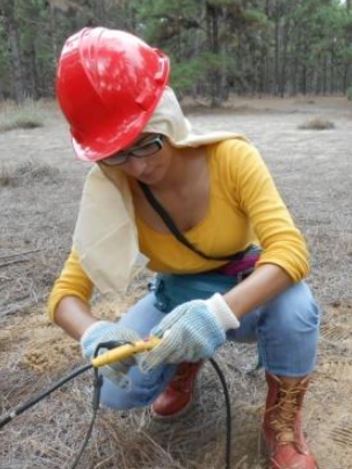
Research Fellow: Andrea Palacios ![]() Profile
Profile
hosted at the Spanish National Research Council (CSIC) in Barcelona
Supervisor
Jesus Carrera
Secondments
University of Lausanne – 3 months (2019)
University of Copenhagen – 3 months (2018,2019,2020)
ACA – 2 months (2020)
Research Objectives
Develop effective and efficient method for the inversion of flow, heat transport, electrical conductivity and conservative and reactive solute transport, which includes new constraints concerning stratigraphy and other concepts linked to site geology.
Apply the new method to ENIGMA sites.
Project description
Effective integration of geological understanding into model inversion remains the single most challenging hurdle for reliable groundwater inversion. The novelty of the procedure we intent to develop lies in including sequential stratigraphy concepts as constraints in the inversion of geophysical and hydrological data for modeling of flow and transport.
In Barcelona province, the Argentona site has been built to monitor the dynamics of seawater intrusion: delineate the shape of the freshwater-saltwater interface, improve our understanding of the mixing process and study the Radium and Radon mobilization through chemical studies.
Inversion will be based on optimizing model fit to hard data on state variables (temperature, heads, conductivity, potential) of fields conditioned to categorical data (textural information from boreholes) and sequential stratigraphy concepts on continuity and orientation of layers. This will allow testing the validity of geological assumptions. The inversion should provide a detailed visualization of the actual processes occurring in the field, which would allow us to gain understanding on the movement of the seawater inland. Specifically, it should allow us to understand Radium mobilization in the freshwater-saltwater mixing zone.
Tasks and methodology
- Active participation in field work at Argentona site (Argentona river basin, Maresme region), a seawater intrusion monitoring site.
- Study of the dynamics of the seawater intrusion in a coastal aquifer.
- Research on modeling and inversion of geophysical data, together with hydrogeological data.
Datasets and database
Electrical Resistivity Tomography (ERT) data acquired on Argentona site is to be found on the H+ database here.
Access to datasets used in the article published in HESS on the H+ database or on the CSIC repository.
Dissemination and communication
Palacios, A., Ledo, J. J., Linde, N., Luquot, L., Bellmunt, F., Folch, A., Marcuello, A., Queralt, P., Pezard, P. A., Martínez, L., del Val, L., Bosch, D., and Carrera, J.: Time-lapse cross-hole electrical resistivity tomography (CHERT) for monitoring seawater intrusion dynamics in a Mediterranean aquifer, Hydrol. Earth Syst. Sci., 24, 2121–2139
https://doi.org/10.5194/hess-24-2121-2020
Abstract & Access to dataset
June 2018: Oral presentation at the 25th Salt Water Intrusion Meeting (SWIM), titled “Time-lapse cross-hole electrical resistivity tomography (CHERT) for monitoring seawater intrusion dynamics in a Mediterranean aquifer”.
Poster presented during the 4th Cargèse Summer School : Time-lapse cross-hole electrical resistivity tomography (CHERT) for monitoring seawater intrusion dynamics in a Mediterranean aquifer
December 2018: Oral presentation at the American Geophysical Union (AGU) 2018 Fall Meeting, Washington DC, USA
